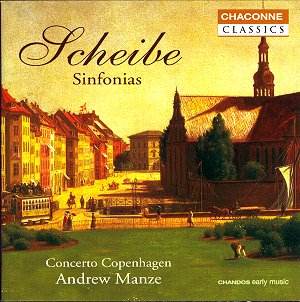Scheibe is an ‘important’ composer in the pre-Classical
style. In 1731, J. S. Bach wrote of his former student: ‘...he is thoroughly
at home not only on the clavier and violin but also in composition,
and accordingly I do not doubt that he will be in a position adequately
to attend to whatever office God may assign to him.*’ Whether that was
intended to damn with faint praise is not immediately obvious. But in
1737 Scheibe wrote of Bach: ‘... he demands that singers and instrumentalists
should be able to do with their throats and instruments whatever he
can play on the clavier. But this is impossible. All the voices must
work with each other and be of equal difficulty, and none of them can
be recognised as the principal voice. Turgidity has led ... from the
natural to the artificial ... one admires the onerous labour and uncommon
effort — which, however, are vainly employed since they conflict with
Nature* ...’ It is thought that Scheibe may have been angry because
Bach was on the selection committee and voted against him when he applied
for a job. Nevertheless, because of Scheibe’s reputation as a writer
and music critic this statement was still circulated and considered
a fair appraisal of Bach’s vocal music until the day after the Mendelssohn
revival of the St. Matthew Passion on March 11, 1829.
Now we have a chance to hear what kind of music Scheibe
wrote and in which he would reasonably be expected to avoid the sins
he attributes to Bach. As expected Scheibe’s music tends to be lyrical,
with a tune supported by accompaniment in anticipation of the Classical
style. His secondary voices are just that; his counterpoint is still
valid and skilfully done; but the melody voice is clearly the ‘principal’
and the accompanying lines clearly subordinate. The performances here
are excellent and clearly recorded. Brass instrument sound is particularly
well balanced, and the virtuoso trumpet soloist in the Sinfonia à
16 deserves special mention. But like much ‘important’ music most of
us will be glad to hear it once or twice. Scheibe’s music is not as
interesting or imaginative as that by other pre-Classical composers
such as the brothers (?) Monn or the Bach brothers. Much of the music
on this disk is dignified, even sombre, in tone, but at its liveliest
it achieves an almost Handelian swagger.
Lest any be misled by the label indication ‘24bit96kHz’
this is a regular CD and plays back at 16/44. This is not a high resolution
CD or a DVD-audio disk. However this notation may indicate that the
sound on this reissue has been digitally enhanced from the original
1994 issue.
*Quoted in The Bach Reader edited by Hans T.
David and Arthur Mendel, Revised Edition 1966.
Paul Shoemaker
